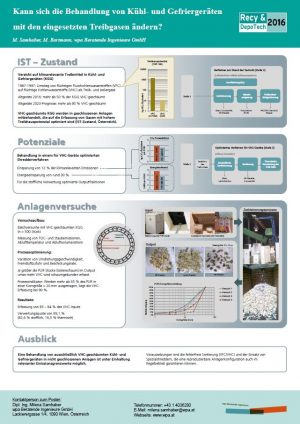REFRIGE-
RATORS
Experiments for the treatment of refrigerators and freezers
2014 until 2016
Since the ban of VFCs as blowing-agents in 1997, industry switched to VHC (mainly Isobutane and Cyclopentane), which has a 100-times lower global warming potential and zero ozone depletion potential. Today VHC-fridges represent more than 50% of end-of-life devices and VFCs are predicted to disappear completely by 2020 from this waste stream. However, the most striking advantage of VHC – the marginal environmental impact compared to other foam blowing agents – has not yet led to alternative treatment procedures; state of the art treatment still focuses on separating the VFC-gases.
In cooperation with a recycler of end-of-life appliances wpa carried out several field-scale batch experiments to improve an alternative treatment technology: the treatment of VHC-fridges only in open shredding systems. wpa was responsible for:
- Planning, improving and supervising the batch experiments
- Sampling the fridges for the analytical detection of propellants
- Capturing the in- and output streams
- Analyzing the output-materials through sieving and sorting
- Creating material- and energy balances
- Assessing and discussing the results of the batch experiments
The study shows that the alternative treatment technology is advantageous concerning energy efficiency and emissions related to climate change. It uses use the relation between particle size of insulation foam in the shredded material and the VHC-binding within the foam-particles to capture more than 90% of contained VHC within the foam (“Foam Capturing”), which is later on used in thermal recovery.
poster-presentation at the Recy&DepoTech 2016
poster_Recy&DepoTech